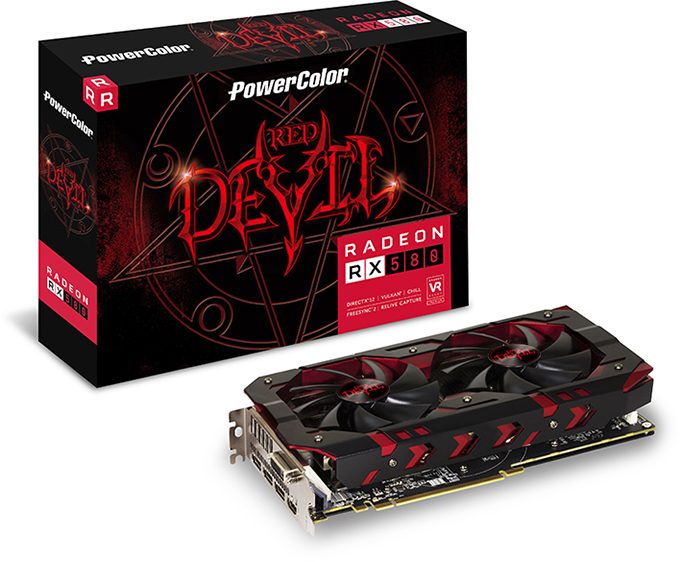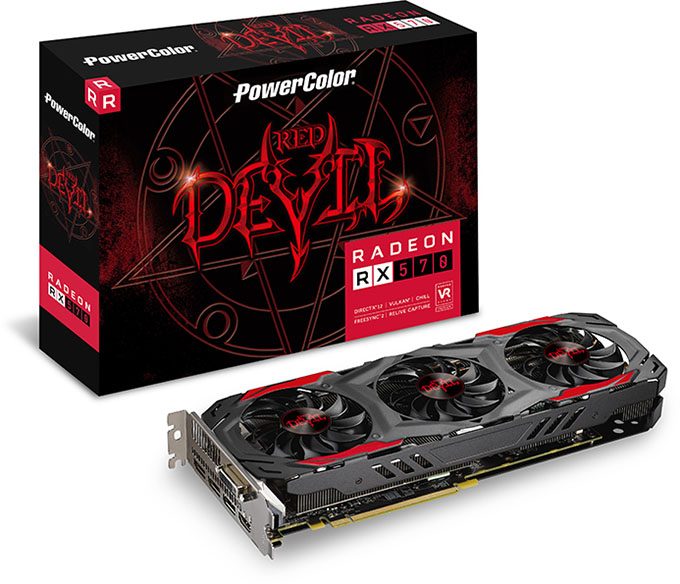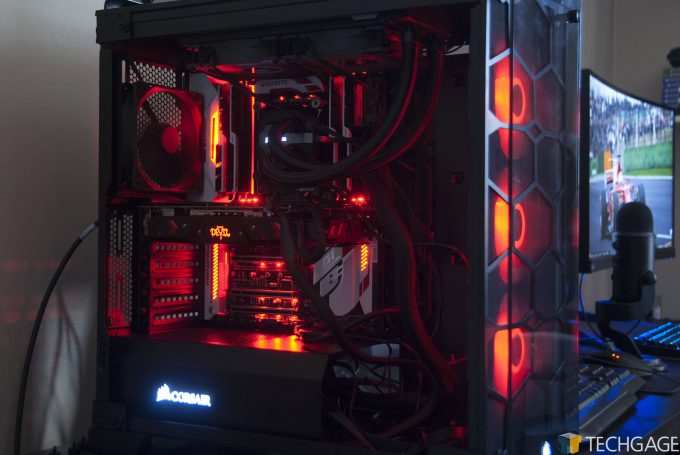- Qualcomm Launches Snapdragon 4 Gen 2 Mobile Platform
- AMD Launches Ryzen PRO 7000 Series Mobile & Desktop Platform
- Intel Launches Sleek Single-Slot Arc Pro A60 Workstation Graphics Card
- NVIDIA Announces Latest Ada Lovelace Additions: GeForce RTX 4060 Ti & RTX 4060
- Maxon Redshift With AMD Radeon GPU Rendering Support Now Available
Polaris, Boosted: A Look At PowerColor’s Radeon RX 570 & RX 580

The hype leading up to the launch of AMD’s Radeon RX Vega is hard to ignore. In fact, it’s the kind of hype that every company dreams of. Given that, a release of an RX 500 series that doesn’t contain Vega could come as a surprise, or even a rude awakening. But, if you’ve been in the market for a new GPU that won’t break the bank, both the RX 570 and RX 580 are well worth checking out.
Page 1 – Introduction, About The Radeon RX 500 Series
It’s been an interesting 2017 for graphics cards so far, but not for the reasons most of us have been hoping. While we did see the release of NVIDIA’s biggest and baddest gamer GPU in the form of the GeForce GTX 1080 Ti, and also saw AMD update its Radeon Pro Duo, Vega has been MIA, with there still being no clear launch date (though rumor says an announcement should happen soon).
At the start of the year, it was assumed that Vega would arrive before the end of Q1, but that’s come and gone – we’re almost half-way through Q2 at this point. It does seem extremely likely that we’ll see it launch before the end of this quarter, though, as it’s a bit of a do-or-die situation for AMD. Ryzen’s success is taking care of the CPU side; it’d be nice to see the same thing on the GPU side.
This all makes the launch of the Radeon RX 500 series a bit odd, but in reality, it’s not odd at all. RX 500 is to RX 400 what R9 300 was to R9 200 – a clock boost, and not a viable upgrade path for those who own the older versions. AMD is keeping competitive the best way it can, and while it might seem strange to simply overclock a series and give it a new name, it has resulted in a slew of new GPU models to peruse and consider.
When the RX 400 series came out, it catered to mainstream audiences – the top-end RX 480 cost a mere $249 for a card bundling in 8GB of GDDR5. Because there haven’t been higher-end cards than that on the red side, a lot of NVIDIA’s lineup has remained uncontested. The hope is that Vega will change that situation, much like Ryzen did on the CPU side. RX 500, then, caters to the same audience that the RX 400 series did, leaving enthusiasts wanting to go higher-end (and AMD) to hold out for Vega.
If you’re in the market for a new GPU, and don’t plan on going high-end, RX 500 was made for you.
| AMD Radeon Series | Cores | Core MHz | Memory | Mem MHz | Mem Bus | TDP |
| Radeon RX 580 | 2304 | 1340 | ≤8192MB | 8000 | 256-bit | 185W |
| Radeon RX 480 | 2304 | 1266 | ≤8192MB | 8000 | 256-bit | 150W |
| Radeon RX 570 | 2048 | 1244 | 4096MB | 7000 | 256-bit | 150W |
| Radeon RX 470 | 2048 | 1206 | 4096MB | 6600 | 256-bit | 120W |
| Radeon RX 560 | 1024 | 1275 | 4096MB | 7000 | 128-bit | 80W |
| Radeon RX 460 | 896 | 1200 | 4096MB | 7000 | 128-bit | 75W |
| Radeon RX 550 | 512 | 1183 | 4096MB | 7000 | 128-bit | 50W |
In addition to the RX 580 and 570, AMD sent along an RX 550, which we’re going to take a look at later (along with the RX 560). As you can see from the table above, this year’s models are not too different from last year’s – as mentioned before, this is a clock boost series, perfect for those needing a card now, but not for those who own the previous version of the respective card.
Because the RX 500 series is clocked higher than RX 400, it means that TDPs have experienced an unfortunate (but expected) boost, with a gain of 35W at the top-end.
Both cards we received come from PowerColor, which makes some of the best-looking models around (it’s hard to go wrong with red + black color schemes). Interestingly, the RX 580 version of the card has a simpler cooler than the RX 570, resulting in an odd situation where the lower-end card draws more power than the higher-end one, as we’ll see in the conclusion (three fans vs. two).


The RX 500 series isn’t the most revolutionary one we’ve seen released in a while (in case it hasn’t been obvious, it’s a clock-boosted RX 400 series), so by this point, you probably know exactly what to expect if you’ve been paying attention to the GPU market over the past year. So, we’ll jump right into testing, for the final time using this particular suite.
Here’s our test PC:
| Graphics Card Test System | |
| Processors | Intel Core i7-5960X (8-core) @ 4.0GHz |
| Motherboard | ASUS X99 DELUXE |
| Memory | Kingston HyperX Beast 32GB (4x8GB) – DDR4-2133 11-12-11 |
| Graphics | AMD Radeon R9 Nano 4GB – Catalyst 16.5.3 AMD Radeon RX 460 2GB – Catalyst 16.10.2 Hotfix AMD Radeon RX 480 8GB – Catalyst 16.9.2 AMD Radeon RX 580 8GB – Catalyst 17.4.2 AMD Radeon RX 570 4GB – Catalyst 17.4.2 NVIDIA GeForce GTX 980 4GB – GeForce 365.22 NVIDIA GeForce GTX TITAN X 12GB – GeForce 365.22 NVIDIA GeForce GTX 1050 4GB – GeForce 375.57 (Beta) NVIDIA GeForce GTX 1060 6GB – GeForce 368.64 (Beta) NVIDIA GeForce GTX 1070 8GB – GeForce 368.19 (Beta) NVIDIA GeForce GTX 1080 8GB – GeForce 368.25 |
| Audio | Onboard |
| Storage | Kingston SSDNow V310 1TB SSD |
| Power Supply | Cooler Master Silent Pro Hybrid 1300W |
| Chassis | Cooler Master Storm Trooper Full-Tower |
| Cooling | Thermaltake WATER3.0 Extreme Liquid Cooler |
| Displays | Acer Predator X34 34″ Ultra-wide Acer XB280HK 28″ 4K G-SYNC ASUS MG279Q 27″ 1440p FreeSync |
| Et cetera | Windows 10 Pro (10586) 64-bit |
My intention was to test the RX 480 again using the same driver as the RX 580, but after testing, I realized that Windows must have stepped in and replaced that driver with an older one. Both the RX 580 and 570 were tested with the exact same driver – it didn’t need to be reinstalled. When I installed the RX 480, which came right after the 570, it booted up fine with the driver already installed, so I went on my merry testing way.
Unfortunately, despite how seamless Windows made it look, that launch driver apparently didn’t support the RX 480, so Windows stepped in and replaced the driver with the most recent one in Windows Update. Because the RX 480 was being retested just for interest’s sake (I wouldn’t recommend people buy it now that the RX 580 series is out, unless it’s a great deal), I decided to stick with those results.
For this reason, the results of the RX 480 might not be 100% identical to the performance of the current driver, but the driver used still encompasses over half a year worth of updates, which gave it an obvious boost in most tests. The current driver might add a touch of performance, but nothing grand.
That all said, framerate information for all tests – with the exception of certain time demos and DirectX 12 tests – are recorded with the help of Fraps. For tests where Fraps use is not ideal, I use the game’s built-in test (the only option for DX12 titles right now). In the past, I’ve tweaked the Windows OS as much as possible to rule out test variations, but over time, such optimizations have proven fruitless. As a result, the Windows 10 installation I use is about as stock as possible, with minor modifications to suit personal preferences.
In all, I use 8 different games for regular game testing, and 3 for DirectX 12 testing. That’s in addition to the use of three synthetic benchmarks. Because some games are sponsored, the list below helps oust potential bias in our testing.
(AMD) – Ashes of the Singularity (DirectX 12)
(AMD) – Battlefield 4
(AMD) – Crysis 3
(NVIDIA) – Metro: Last Light Redux
(NVIDIA) – Rise Of The Tomb Raider (incl. DirectX 12)
(NVIDIA) – The Witcher 3: Wild Hunt
(Neutral) – DOOM
(Neutral) – Grand Theft Auto V
(Neutral) – Total War: ATTILA
If you’re interested in benchmarking your own configuration to compare to our results, you can download this file (5MB) and make sure you’re using the exact same graphics settings. I’ll lightly explain how I benchmark each test before I get into each game’s performance results.
Support our efforts! With ad revenue at an all-time low for written websites, we're relying more than ever on reader support to help us continue putting so much effort into this type of content. You can support us by becoming a Patron, or by using our Amazon shopping affiliate links listed through our articles. Thanks for your support!






